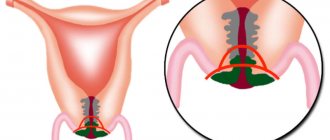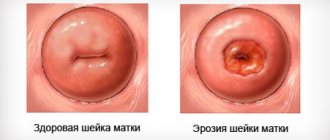Da!Zachatie
Website about pregnancy, from planning to birth
Popular
Important nutritional principles when planning pregnancy
Home › Commercial diagnoses
Does erosion prevent you from getting pregnant?
Women hear this diagnosis quite often, but how true is it and how does it relate to reproductive function? What kind of disease is this and why do progressive gynecologists believe that such a diagnosis simply does not exist?
- 1 What is cervical erosion
- 2 Why and when do you still need to cauterize?
- 3 Does erosion interfere with conception?
- 4 When can you get pregnant after cauterization?
- 5 Common myths about cervical erosion
- 6 Summary
Cauterization of cervical erosion when planning pregnancy
The cauterization procedure for cervical erosion is a group of therapeutic techniques whose goal is to eliminate the disease by destroying pathological cells. There are several ways:
- diathermocoagulation;
- cryodestruction;
- laser vaporization;
- radio wave coagulation;
- argon plasma ablation method;
- electroconization;
- ultrasound;
- chemical or medicinal cauterization.
Diathermocoagulation involves treatment with electric current. The method is considered outdated and the most traumatic.
Cryodestruction is a method of getting rid of erosion using cauterization with nitrogen. The specialist freezes the pathological cells, thereby stopping their destruction.
Laser vaporization involves laser removal of erosion. The method is gentle but effective.
Radio waves are used to carry out radio wave coagulation. The method of getting rid of the disease is promising and less traumatic.
Erosion is also treated with argon, a method called argon plasma ablation.
To perform this, a device is used in which argon undergoes ionization by high-frequency currents and a plasma beam, and the action occurs exclusively in a targeted manner.
Electroconization - removal of erosion by partial removal of the cervix.
Ultrasound is a method of getting rid of erosion by exposing it to ultrasound.
Chemical or medicinal cauterization involves the use of a special drug, with the help of which the specialist causes tissue necrosis, forms a scab, which is subsequently replaced by a new layer of epithelium.
It is worth noting that the gynecologist excludes contraindications to the procedure, refers the woman for a full examination and prepares her for manipulation.
The cauterization procedure is performed in the second half of the cycle. First of all, the doctor treats the area and determines its boundaries, after which he destroys the erosion cells. Next, a scab or film forms on the treated area. After some time, the tissue damaged during the procedure comes off, healthy tissue is formed, and a scar often appears in place of the affected area.
Recovery after cauterization
The recovery period after erosion treatment is usually 8 weeks. Failure to follow the advice of a gynecologist and neglect of your health can lead to deterioration and complications:
- inflammatory process in the ovaries and fallopian tube;
- heavy bleeding;
- erratic menstrual cycle;
- complete scarring;
- secondary formation of erosion;
- endometriosis.
A common occurrence during the healing period is a slight aching pain in the lower abdomen, accompanying the regeneration process after any type of cauterization of erosion. It is also normal for small discharge to appear, which will soon disappear on its own.
Important! Small discharge, pain, itching after surgery are a sign of tissue restoration. At this time, an increase in body temperature may be observed. All these symptoms go away on their own after 1 to 2 months.
After the procedure, you must give up bad habits for 8 weeks. Therefore, to the question of whether it is possible to drink alcohol after cauterization, the answer is negative. Alcoholic drinks lead to vasodilation, a drop in blood pressure, and this provokes increased blood circulation and delays the healing period of wounds.
Possible complications
To ensure that cauterization of erosion does not cause complications, a woman must follow a number of recommendations.
Avoid sexual intercourse for at least a month after the procedures. Otherwise, the cervix will take much longer to recover. Lack of sexual activity will prevent infection with viruses, which are provocateurs of various diseases;
You cannot douche with potassium permanganate, alcohol or iodine, otherwise there is a high probability of cauterizing the tissue, which will delay the healing process.
Scheme
Drug therapy is more often prescribed to nulliparous girls, pregnant women and women who have given birth if the size of their cervical erosion is at the initial stage of development.
Treatment of cervical erosion after childbirth is divided into several stages:
- thorough diagnosis of the disease, study of all examination results;
- antibacterial therapy if there are pathogenic microorganisms in the microflora of the genitourinary system;
- prescribing anti-inflammatory/wound-healing drugs to eliminate the cause of the pathology;
- stabilization of hormonal levels;
- strengthening the immune system.
For local treatment of erosive lesions, tampons with medications, vaginal suppositories, and ointments .
Self-medication is strictly contraindicated! Specific medications and their dosage are prescribed only by the attending physician.
Treatment of cervical erosion before planning pregnancy
The question of whether something needs to be done urgently or whether you can wait depends on what exactly the doctor means by voicing the diagnosis of “cervical erosion.” In the modern world, it is hardly possible to make such a diagnosis, especially in women who are planning a pregnancy, at the first examination.
If a suspicion arises, the doctor must take a smear from the suspicious area of the mucosa and perform a cytological analysis, which will accurately show whether there are any dangerous changes in the cells. Another fairly informative diagnostic method that has been used by foreign doctors for more than 20 years is colposcopy, which involves examining tissues using a special colposcope device.
If, based on the results of the research, a precancerous condition is suspected, a small amount of tissue will be required to perform a biopsy and clarify the diagnosis. Surgery in a delicate area can (but does not necessarily) cause harm by causing structural changes in tissue, which can cause problems with pregnancy and childbirth.
However, if cell changes have already begun, you will have to agree to intervention, since in this case time is very important. Modern doctors, unlike gynecologists of the old, Soviet school, are in no hurry to send women of childbearing age for moxibustion, but if such a recommendation is made, it is worth consulting with several more specialists before making a final decision.
Cervical erosion is not an obstacle to pregnancy, but it is still better to plan to conceive a child after it is eliminated. After all, it is important not only how cervical erosion affects conception. But also the reasons why it arose. After all, some of them are themselves unsafe pathologies and can harm the unborn child.
So, the possible causes of the pathology:
- hormonal changes in a woman’s body, menstrual irregularities;
- regular and long-term use of oral contraceptives;
- infections that are sexually transmitted and are a risk factor for the development of inflammation;
- physical and mechanical trauma to the cervix;
- genetic predisposition;
- bad ecology;
- exhaustion of the body;
- failure to comply with basic rules of intimate hygiene.
With cervical erosion, it is possible to get pregnant, but it is better to be cured first. Most experts recommend first getting rid of the disease, and only then planning to conceive a child.
To get rid of cervical pathology, a woman needs to undergo several studies and only after that the doctor will decide on the advisability of using one or another type of treatment.
The choice of therapeutic tactics is influenced by several factors: the cause of the development of the pathological process, the presence of infection, the features and main characteristics of erosion, and the like.
In modern medical practice, doctors use the following techniques to cure erosion and then get pregnant:
- local treatment with antibacterial agents. They allow you to get rid of infection, and thereby reduce the manifestations of erosion and promote healing;
- cauterization with chemicals (mixture of acids);
- laser destruction of the defect. The laser beam affects the affected tissue without subsequent scar formation;
- cryodestruction of erosive formation with liquid nitrogen;
- Diathermocoagulation is a cauterization technique using electric current. This method gives good results, but scarring may occur after it, and this is undesirable for those planning a pregnancy;
- excision of an erosive defect using radio waves, which has the working name “radio knife”;
- folk treatment, the effectiveness of which has not been fully proven. Therefore, practicing doctors treat it with caution, not believing that using traditional medicine recipes can eliminate the disease.
What is erosion
When it comes to the diagnosis of “cervical erosion,” the concept indicates ectopia of the epithelium. The junction line between the two types of epithelium shifts. If the cylindrical one gets into the acidic vaginal environment, it becomes brightly colored and may increase in size. Multilayered squamous epithelium (non-keratinizing), always lighter (pink color) and therefore against the background of the same shade of the vagina and epithelium, cylindrical - stands out. Its surface is inflamed and bright red. That’s why experts call this phenomenon “erosion.” But in fact, such changes in the mucous membrane in some cases are not damage.
Ectopia or so-called “erosion” is often observed in adolescence and does not require treatment. Every year the girl’s body develops as nature intended. By the age of 23, the junction moves to its permanent place.
According to statistics, in 66 cases out of 100, ectopia of the cervix was detected in 20-year-old girls. If at this age a girl begins to have regular sex life, then there is a high risk of getting an infection and developing an inflammatory process. This happens because the protective properties of the mucous membrane are reduced and the infection easily enters the body.
Gynecologists do not really like the pronounced color of the epithelium (scarlet color). During pregnancy, ectopia may bleed a little because the blood supply to the cervix increases. This is also possible after sexual intercourse, regardless of whether the woman is pregnant or not. After the birth of a child, pseudoerosion disappears without intervention or treatment.
The manifestation of such erosion can also occur in a pregnant woman and go away on its own after the birth of the baby. Doctors recommend treating erosion after the birth of the first child, since changes in the epithelium are a direct route to infection.
If the doctor sees that the size of the mucous membrane remains within normal limits and the erosion does not grow, there are no inflammatory processes in the genital organs, then the erosion is not treated before childbirth. But here each specialist decides individually what to do, taking into account the lesions.
Planning pregnancy after cauterization of cervical erosion
When can you get pregnant after cauterization of erosion? Is it even possible to get pregnant after cervical erosion if scars have formed due to intensive treatment? In the vast majority of cases, you can get pregnant, although there are exceptions.
Does moxibustion affect women's reproduction and can it lead to infertility? Typically, pregnancy after cauterization of cervical erosion does not differ from the normal process of bearing a child. After all, most modern methods do not leave scars.
If scars occur, then among such women the percentage of miscarriages is slightly higher. After all, scars make the neck less elastic, and it performs its functions worse.
Very rarely, cauterization of the cervix causes the formation of multiple scars, which leads to a sharp narrowing of the cervical canal, and the woman becomes infertile. But there is no need to despair: there are techniques that eliminate such scars.
- How long can it take to get pregnant after cauterization, cryodestruction, diathermocoagulation and other procedures?
- It all depends on the individual patient: on the processes of tissue regeneration, scar formation, immune reactivity, and the duration of the rehabilitation period.
- How long it will take to prepare for pregnancy depends on the woman herself, her desire to be cured, and strict adherence to all the specialist’s recommendations.
An erosive defect on the cervix is a very aggressive pathological formation, which without treatment can cause the development of a number of complications, including cancer.
Therefore, women who are planning a pregnancy should regularly visit a gynecologist and, if erosion is diagnosed, begin its treatment immediately.
When diagnosing erosion, women are most concerned with the question of how the pathological condition affects reproductive functions. Gynecologists reassure on this score: it is possible to become pregnant with cervical erosion, and this happens very often.
An unpleasant but possible combination of conditions is acceptable; however, it is considered safe only in cases where there is no suspicion of oncology or the development of serious infectious diseases. The disease does not interfere with conception and does not deprive a woman of the ability to bear children, but, like any gynecological ailment, this pathology requires timely treatment.
Diagnosis of erosion
The disease can only be detected by examination in a chair. The doctor inserts speculum and assesses the condition of the mucous membranes, paying attention to the epithelial layer and the cervix. If erosion is suspected, a more detailed examination - colposcopy - will be required. As a preventative measure, every woman should undergo a similar examination 2 times a year. The procedure is quite simple and painless. If necessary, the doctor makes a diagnostic test like this: irrigates the mucous membrane with Lugol's solution or acetic acid to see the affected areas.
3 days after the examination, the woman needs to visit the doctor again to submit material for research - this is cytology or a study of the composition of the cells of the cervix. Doctors call this testing a “PAP test.” The material is collected using a tool called a “conchotome”.
When planning a pregnancy, every woman should undergo such an examination, even if there are no visible changes in the epithelium on the cervix.
To make a final diagnosis of “cervical erosion”, it is necessary to do a biopsy - this is the sampling of a small affected area (forceps biopsy). It is not painful and the material is collected in the clinic during a routine examination.
There is also another biopsy method - a knife biopsy, when it becomes necessary to cut out a small piece of the cervix. In this case, it is necessary to apply stitches. This manipulation is performed under anesthesia. But this is in extreme cases; usually it is enough to do a biopsy with a conchotome.
Is cervical erosion dangerous when planning pregnancy?
During pregnancy, a woman’s body is in a state of immunodeficiency to prevent rejection of a fetus that is genetically foreign to her. Against this background, existing cervical erosion is very easily infected by pathogenic microbes, causing intoxication and an inflammatory process. Although erosion itself does not pose a danger to the embryo, a purulent infection that complicates it can spread to the fetal membranes and penetrate the baby’s body. Depending on the gestational age, this can lead to disruption of the development of its internal organs with the formation of congenital anomalies or defects, to intrauterine sepsis, to the development of a threat of miscarriage, and even to fetal death.
A woman’s immune system normally identifies and neutralizes emerging tumor cells. But in a pregnant woman this process is suppressed. Therefore, the risk of malignancy of an existing pseudo-erosion increases several times, especially when complicated by the carriage of papilloma or herpes viruses or an untreated sexually transmitted infection.
What is erosion and what is the danger?
An erosive lesion is diagnosed if areas of redness are detected on the surface of the vaginal membrane during a speculum examination. These lesions can be multiple or single.
Interesting! Cervical erosion is the most common diagnosis made by doctors to parous and nulliparous women; more than 50% of women worldwide experience the lesion.
There are 3 forms of erosion:
- True – is the result of external factors (trauma to the mucous membranes). After damage, the mucous membrane sloughs off, and erosion occurs in place of the lining layer; it has an irregular shape, red color, and bleeding is possible.
- False - manifests itself as a result of the replacement of epithelial cells with cylindrical ones. Often occurs after childbirth (45% of women). Symptoms appear as a result of infection; in other cases, the disease occurs in a latent form.
- Congenital - occurs due to displacement of the boundaries of the columnar epithelium lining the cervical canal. This change often occurs in the prenatal period, and is therefore called congenital.
The list of the main reasons provoking the development of erosive lesions includes:
- inflammatory processes occurring in the female genital organs;
- sexually transmitted infections;
- women's hormonal imbalances;
- injuries to the mucous membranes of the external genitalia;
- early onset of sexual activity, early childbirth.
The danger of the disorder is that it does not manifest itself for a long time, and the woman does not consult a doctor. Against this background, polyps and dysplasia (precancerous condition) appear. If left untreated, erosion can cause cervical cancer.
Erosion is not a contraindication for childbirth, but against its background, the risk of ruptures in a woman increases, because the affected neck of the organ stretches less well. Cauterization is contraindicated at this time; treatment is carried out using medicinal methods.
Planning pregnancy after treatment of cervical erosion
Removal of damaged cervical tissue is not an obstacle to egg fertilization. If all medical instructions are followed, the development of the fetus after cauterization will occur without complications. During this procedure, all pathological cells are destroyed. Therefore, theoretically, after treatment of cervical erosion, you can become pregnant.
However, not all so simple. Yes, the operation will help restore the protective function of the organ, but in order for the gestation period to proceed normally, the woman must comply with several conditions.
- Firstly, it is impossible to plan conception immediately after the operation, because wounds will appear at the site where the pathological cells were removed. We need to wait for them to heal completely.
- Secondly, during the recovery period you will have to abstain from sexual intercourse. The fact is that sex after erosion can lead to infection of the female genital organs. Then the wound healing process will stop.
Getting pregnant after cauterization of cervical erosion can sometimes be difficult. Treatment of the disease leads to disruption of the process of secretion of cervical mucus, which facilitates the entry of sperm into the mature egg.
During the cauterization procedure, the endometrium can be injured. If this uterine layer is damaged, the fertilized egg will not attach to it properly. The result of such a conception will be a miscarriage or ectopic pregnancy.
Planning pregnancy after cauterization of cervical erosion with radio waves
The most modern and safe method of treating erosion. During the manipulation, evaporation of the changed tissue occurs under the influence of high frequencies of radio waves. In this case, healthy areas of the mucous membrane are not damaged, and the risk of bleeding is minimized. After radio wave therapy, there are no scars left, and the recovery period is quick and painless. You can plan a pregnancy a month after the procedure.
Radio wave therapy is considered the optimal method for treating cervical erosion in nulliparous women. The procedure does not interfere with pregnancy, and the absence of scars ensures good dilatation of the cervix during childbirth. Complications after this method of treatment are quite rare.
Pregnancy after laser coagulation
The method is based on evaporation of erosion with a laser beam. In this case, the laser does not affect the surrounding healthy tissue, targeting only the lesion. After this treatment, no scars remain, and healing occurs within 3-4 weeks. The laser coagulation method is also recognized as one of the best for the treatment of cervical erosion in women who are just preparing for motherhood. After laser therapy, there are no problems with bearing and giving birth to a child. This treatment also does not have a negative effect on the course of labor.
Pregnancy after cryodestruction
Cryodestruction is the treatment of erosion with liquid nitrogen when exposed to low temperatures. After the procedure, a scab remains on the cervix, which falls off after a few months. After the procedure, there are no scars, which means that pregnancy and childbirth proceed without complications. The only disadvantage of cryodestruction is the long recovery period. Experts recommend planning a pregnancy after this treatment method no earlier than 6 months. Only after six months can the cervical mucosa fully recover and regain all its protective properties.
Pregnancy after diathermocoagulation
Diathermocoagulation involves cauterizing erosion with an electric current. This method is considered quite traumatic. After diathermocoagulation, scars may form, narrowing and deformation of the cervical canal. As a result, many women have problems conceiving and carrying a pregnancy. The birth process rarely proceeds well after diathermocoagulation. Formed scars interfere with the normal opening of the cervix during labor, which often leads to a protracted course. In some cases, childbirth in women who have undergone cauterization of erosion with electric current ends with a caesarean section.
At the moment, diathermocoagulation is used quite rarely. Doctors are gradually moving away from this method, offering younger patients more gentle treatment options for cervical erosion.
Pregnancy after chemical coagulation
The essence of the method is to use special drugs to get rid of cervical erosion. Modern doctors rarely use this method of treatment, since it does not guarantee a complete cure. The course of pregnancy will depend on the success of the procedure. If during therapy all erosion is not removed or scars remain, problems may arise with bearing and giving birth to a child.
After treating cervical erosion, you must wait a certain period of time before conceiving a child. You can plan a pregnancy after radio wave therapy and laser coagulation within a month, but after cryodestruction you will have to wait six months. More precise recommendations can be given by the attending physician during the examination after treatment.
Recommendations after cauterization
We found out that it is possible to get pregnant after treating erosion. However, to avoid possible risks, you need to plan conception at least 1 month later, that is, after the completion of the recovery period.
Doctors strongly do not recommend giving birth if there is a red area in the area of the genital organ.
To avoid problems during pregnancy and childbirth after the body has been restored, you need to listen to these tips:
- Do not use tampons in the first days of desquamation. Give preference to gaskets.
- Avoid any physical activity. In the first month after coagulation, it is recommended to remain in bed.
- You will have to abstain from sexual intercourse.
- Avoid visiting the sauna or bathhouse. Taking a hot bath is also not recommended.
- Taking medications that contain aspirin is prohibited.
- Follow a therapeutic diet.
- Protect yourself from stress and worry.
We must not forget that pregnancy after treatment of erosion is possible only after completion of the recovery stage.
How is pregnancy progressing after erosion treatment?
Since tissue restoration occurs slowly after cauterization of the red area, planning a pregnancy in the first postoperative month is not recommended.
If the healing of all wounds is not complete, then complications may arise during the pregnancy stage.
After coagulation, a woman can become a mother if her cervix begins to secrete protective mucus again. Otherwise, the child may become infected while in the womb.
It is a mistake to believe that the procedure of cauterization of erosion is the only treatment. To eliminate pathology, it is necessary to eliminate the cause of its occurrence. Without this, the reappearance of the red area is inevitable.
Childbirth after cauterization of cervical erosion will take place without complications if the woman followed the advice of her attending physician, did not lift heavy objects in the postoperative period, and avoided stress. But in order to prevent reproductive dysfunction in the future, it is important to undergo regular examinations by a gynecologist. Before planning motherhood, a woman who has recently had a red area cauterized should definitely visit this specialist.
Cervical erosion and pregnancy planning - forum
You can find a discussion of uterine erosion and pregnancy on forums and thematic sites:
Show
- https://deti.mail.ru/forum/v_ozhidanii_chuda/planirovanie_beremennosti/planirovanie_beremennosti_i_jerozija_shejki_matki_1454843854/
- https://www.babyplan.ru/forums/topic/149-eroziya-sheyki-matki-i-beremennost/
- https://www.woman.ru/health/Pregnancy/thread/4360029/
- https://www.baby.ru/community/view/22562/forum/post/2555034975/
- https://www.u-mama.ru/forum/waiting-baby/pregnancy-and-childbirth/467694/
- https://forum.komarovskiy.net/viewtopic.php?t=2597
- https://www.babyblog.ru/theme/eroziya-pri-beremennosti-forum
- https://forum.materinstvo.ru/lofiversion/index.php/t295518.html
- https://forum.sibmama.ru/viewtopic.php?t=6873
- https://forum.ditenok.com/showthread.php?t=1632
- https://mamochki.by/forum/44/435956/eyroziya_i_planirovanie_bereme.html
- https://sovet.kidstaff.com.ua/question-225473
- https://www.chado.spb.ru/forum/razdel179/tema40100/
- https://www.stranamam.ru/post/2849453/
- https://eva.ru/static/forums/53/2007_12/1185090.html
- https://eka-mama.ru/forum/part277/topic66969/?PAGEN_1=5
- https://mama.tomsk.ru/forums/viewtopic.php?t=5665&start=500
- https://conf.7ya.ru/fulltext-thread.aspx?cnf=Planning&trd=20984
- https://club.passion.ru/planirovanie-beremennosti/eroziya-t70755.html
- https://khabmama.ru/forum/viewtopic.php?t=53436&start=30
This article is posted for educational purposes only and does not constitute scientific material or professional medical advice. Always trust your doctor first!










